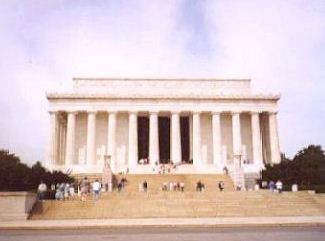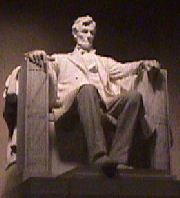Home | News | Books | Speeches | Places | Resources | Education | Timelines | Index | Search
© Abraham Lincoln OnlineAbraham Lincoln Memorial
Lincoln Memorial Circle
Washington, D.C.
The Lincoln Memorial suits its surroundings so well that it seems to have always been there. The city's master designer, Pierre L' Enfant, could hardly have imagined a better architectural anchor to the west end of the Mall, the grassy area he visualized between the Capitol Building and the Potomac River.
Behind the memorial to the west lies Arlington National Cemetery and the stately Lee-Custis Mansion; to the east you see the Washington Monument and Capitol Hill. The massive sculpture of Lincoln faces east toward a long reflecting pool. The peaceful atmosphere belies the years of disagreement over what kind of monument to build and where.
Help from Lincoln's Friends
In 1910 two members of Congress joined forces to create a memorial which honored Lincoln. Shelby M. Cullom and Joseph G. Cannon, who had known Lincoln in Illinois, pushed through a Lincoln Memorial bill which President Taft signed on February 11, 1911. The bill created the Lincoln Memorial Commission to oversee the project and set aside $2 million in funds. The final cost, however, was $3 million.
Before the commission completed plans to build in what was known as the Potomac Flats, it considered various locations and memorial ideas which ranged from a highway to a huge pyramid. John Hay, one of Lincoln's White House secretaries, promoted the Potomac location, saying that the monument should stand alone, distinguished, and serene.
The Building
On Memorial Day, May 30, 1922, the building was dedicated, 57 years after Lincoln died. About 50,000 people attended the ceremonies, including hundreds of Civil War veterans and Robert Todd Lincoln, the president's only surviving son. The main speakers were President Warren Harding, former President William Howard Taft, and Dr. Robert Moton, principal of the Tuskegee Institute, who delivered the keynote address.
New York architect Henry Bacon modeled the memorial in the style of a Greek temple. The classic design features 36 Doric columns outside, symbolizing the states in the Union at Lincoln's death. The building measures 204 feet long, 134 feet wide, and 99 feet tall, with 44-foot columns. It blends stone from various states: white Colorado marble for the exterior, Indiana limestone for the interior walls, pink Tennessee marble for the floor, and Alabama marble for the ceiling.
© Abraham Lincoln OnlineThe Statue Daniel Chester French, the leading American sculptor of the day, created the famous statue of Lincoln which dominates the interior. He remarked, "We all have an inner consciousness of how Lincoln looked or must have looked, and this was mine." The memorial plans originally specified a 12-foot bronze statue, but it proved out of scale for the huge building. The finished statue is 19 feet tall, carved of 28 blocks of white Georgia marble. French later had special lighting installed to enhance the figure. Visitors sometimes ask if the hands have special significance, such as forming the letter "A" in sign language, but there is no indication French intended it.
Inscriptions
Directly behind the Lincoln statue you can read the words of Royal Cortissoz carved into the wall: "IN THIS TEMPLE AS IN THE HEARTS OF THE PEOPLE FOR WHOM HE SAVED THE UNION THE MEMORY OF ABRAHAM LINCOLN IS ENSHRINED FOREVER."
The chamber north of the statue contains Lincoln's Second Inaugural Address, topped by a mural by Jules Guerin called "Reunion." Guerin also painted the "Emancipation" mural in the south chamber over the Bliss version of the Gettysburg Address.
Visiting Information
This site on 23rd Street NW is maintained by the National Park Service and is open 24 hours a day. Parking near the memorial is extremely limited, even at night, when the monument is best viewed. The closest Metro stop is Foggy Bottom. For more information write: National Capital Parks, 900 Ohio Drive SW, Washington, D.C. 20242 or call 202/426-6841.
Related Link
Abraham Lincoln Memorial (National Park Service)
Related Reading
National Park Service. The Lincoln Memorial: A Guide to The Lincoln Memorial, District of Columbia. Washington, D.C.: U.S. Department of the Interior, 1986.
Peterson, Merrill D. Lincoln in American Memory. New York and Oxford: Oxford University Press, 1995.
Thomas, Christopher A. The Lincoln Memorial & American Life. Princeton University Press, 2002.
Home | News | Education | Timelines | Places | Resources | Books | Speeches | Index | Search Text and photos copyright © 2019 Abraham Lincoln Online. All rights reserved. Privacy Policy


